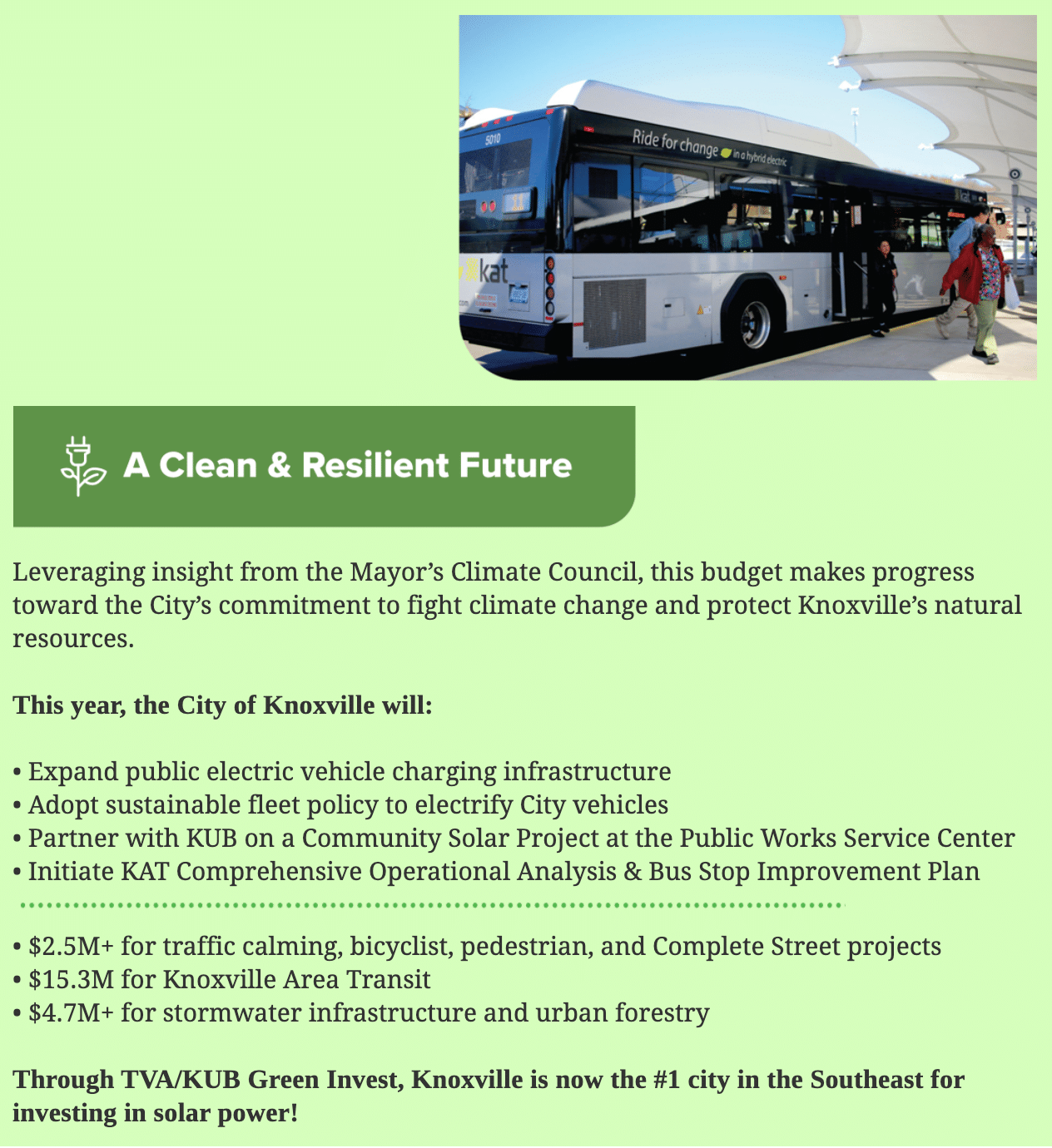This week, the Knoxville Mayor’s Climate Council held its penultimate meeting to discuss an updated City Sustainability work plan, and Knoxville City Council passed the City budget with climate provisions.
Guest Blog | May 20, 2021 | Climate Change, Energy Policy, TennesseeThis blog post was written by Brady Watson, former Civic Engagement Coordinator for the Southern Alliance for Clean Energy.
The Knoxville Mayor’s Climate Council met on Monday, May 17, after several months of gathering input from the community and stakeholders, to update the City’s Sustainability work plan. You can view a recording of the meeting here. The Council convened approximately one year ago to develop a plan to meet the City’s goal of reducing community-wide greenhouse gas emissions 80% from 2005 levels by 2050. For more context, please check out our earlier blog post on the January meeting which summarized the group’s work over the past year.
Mayor Indya Kincannon led off the meeting by highlighting several budget proposals that were to be voted on during the Knoxville City Council meeting on Tuesday, May 18th (more information on that vote below), several of which were influenced by the input of the Climate Council over the past 12 months. They include:
- $1.2 million to support Knoxville Area Transit’s conversion of its fleet to electric buses
- $60,000 for public electric vehicle (EV) charging infrastructure
- $90,000 for City fleet EV charging infrastructure
- $60,000 in Green Switch Match funding to offset 80% of emissions in the Knoxville Convention Center
Mayor Kincannon also mentioned prior work by the Knoxville Utilities Board (KUB) to source more than 500 megawatts (MW) of solar in the Tennessee Valley Authority (TVA) Green Invest program and the new community solar project that KUB is developing.
City Sustainability Director Brian Blackmon indicated that the updated work plan, which is currently being finalized by the Council, would be more community-focused than it has been in past years, with an emphasis on a coherent message and vision as opposed to shovel-ready projects. Below is a summary of the past year of meetings and work conducted by the Council. After the work plan is finalized (with a target date of May 22nd) the plan will be publicly unveiled, and City Council will be updated on priorities identified. The Sustainability Department website will also be updated in order to:
- Draw a direct connection to budget and funding in a dynamic setting
- Highlight partner programs that support those goals
- Create and add trackers for additional metrics identified
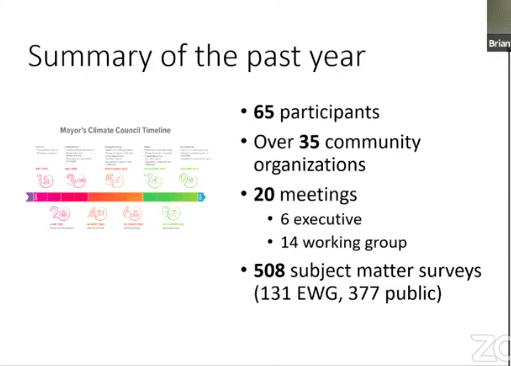
Mayor Kincannon reiterated the importance of making the process of updating the City’s Sustainability Work Plan and the work of the Climate Council publicly accessible for accountability and transparency. Thus far, equity has been centered in the Council’s work as the Equity Working Group (EWG) has conducted several surveys to collect community input and screened proposed strategies through an equity lens. The group delivered a memo on findings and recommendations in April, and Sustainability staff deferred to EWG rankings overall by removing strategies unlikely to advance equity outcomes. Erin Rose from Three3, who chaired the EWG, asked about metrics for measuring equity impacts for future, shovel ready projects, and suggested adding them as more projects are identified. Blackmon indicated that he was fully supportive of that, and would welcome ongoing discussions with the EWG to ensure future projects are evaluated from an equity perspective. SACE Executive Director Dr. Stephen Smith asked about timing for public and City Council engagement, to which Blackmon replied that if everyone on the Council felt good with the work plan, then a June date would make sense for a more formal unveiling. Smith also raised the potential for forthcoming federal funding as part of an infrastructure plan and suggested that the city should be ready to take advantage of federal dollars. Mayor Kincannon and Socially Equal Energy Efficient Development (SEEED) Executive Director Stan Johnson agreed that having a plan prepared in the event of federal funding becoming available would be helpful.
Blackmon next unveiled the updated format for ranking possible strategies for the sustainability work plan, measured by potential emission reductions (indicated by the green clouds, with more clouds meaning more potential emission reductions), length of time working group experts believed strategies would take to implement (with more clock icons indicating longer time to implement), and potential community benefit/likeliness to advance positive equity outcomes (shown by people icons with larger groups of people indicating more potential for positive community benefit).
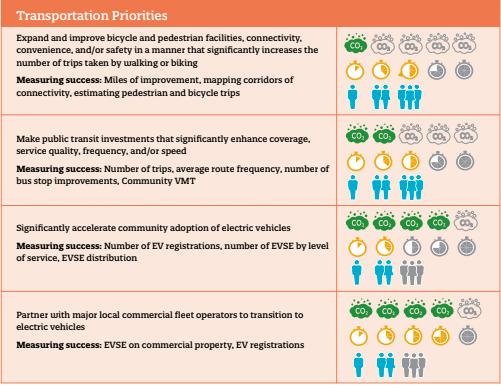
Based on these evaluation criteria, the Climate Council ranked potential action strategies by priority, including input from the various committees and public survey input from the community. The slide below shows the strategy rankings for each sector, with public survey priority rankings in parenthesis. For example, under transportation, the strategy “work with commercial fleets to transition (to EVs)” was ranked #4 by the council’s metrics, but was not ranked among public survey respondents. Dr. Smith pointed out that given the importance of transportation to overall emissions reductions and fleet electrification, public education would be key, as would the Mayor’s use of the bully pulpit to encourage the transition to EVs. Mayor Kincannon concurred, saying that she recently met with representatives from Fraley and Schilling, a local trucking company that is in the process of making its fleet more efficient and aerodynamic, citing the environmental and economic benefits of going green. Regarding the bully pulpit and encouraging lifestyle/business changes, the Mayor outlined her philosophy that “carrots and praise work better than sticks and shame,” so perhaps awards for carbon reduction could help drive the changes needed to reduce emissions.
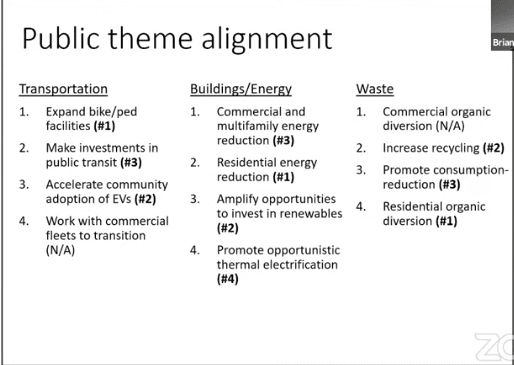
Amy Hathaway from the Forest Heights Neighborhood Association next asked about how to drive community adoption of EVs, stating that in her experience, most people could not afford EVs, and also wondered about the equity implications. Erin Rose mentioned that the questions surrounding EV affordability were why the EV strategies were listed in the draft work plan as “somewhat likely” to advance equity outcomes, rather than simply “likely.” Brian Blackmon noted that the city has been offering public EV charging that is free to community members, and noted the additional charging infrastructure coming down the pike. Dr. Smith noted that as more EVs penetrate the market, and more manufacturers increase their EV offerings, price points will come down for new vehicles and used vehicles in the secondary market. He also pointed out that more education is needed around the savings that can be realized based on maintenance and fuel costs over the life of an EV. Stan Johnson also mentioned the idea of rebates for low-income community members toward EV purchases to help alleviate the equity concern.
Blackmon then shifted to more technical slides showing greenhouse gas emissions reductions by strategies and listed two key items as critical drivers: electrification of private transportation and decarbonization of energy systems. One factor that is still to be determined is the adoption of heavy-duty EVs, but together, energy in buildings and the transportation sector make up 64% of the community’s emissions.
The slide below shows a variety of possible carbon reduction scenarios along a timeline toward 2050. The red dotted line assumes business as usual/no changes, the brown dotted line shows targets set forth by the city, and the lowest dark green line shows the likeliest path for meeting the goal of 80% greenhouse gas reduction by 2050. It also assumes 47% adoption of heavy-duty EVs, though that is a conservative estimate and Blackmon indicated many experts expect higher adoption. He again reiterated the importance of the electrification of transportation, and decarbonization of the energy sector, which can be most easily observed at the 2030 juncture when the possible paths start to diverge.
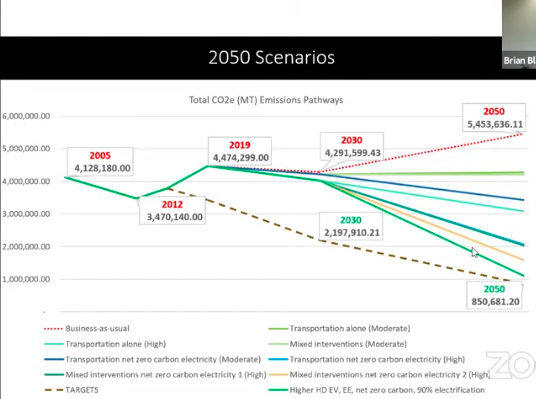
Finally, the Council agreed – after suggestions by the Mayor and Dr. Smith – to leave the potential for an ad hoc meeting of the Climate Council on the table, pending the influx of federal dollars from a yet-to-be-determined infrastructure bill, and a target to reconvene the full council in November. In the meantime, the work plan will be updated, and possible workshops with City Council could be planned. Dr. Smith also mentioned the importance of a clean electricity standard (which you can learn more about and send an email to Congress to support here). Both City staff and Climate Council members indicated their willingness to get to work to ensure Knoxville meets its climate goals.
Knoxville City Council approves City Budget with climate initiatives included
At their May 18 meeting, Knoxville City Council approved the Mayor’s proposed 2021-2022 budget, including funding for EV charging infrastructure; matching funds for an electric bus grant to increase the number of electric buses in the city’s fleet; and funds to participate in TVA’s Green Match program to help offset emissions at the Knoxville Convention Center. With the Climate Council completing its input on the Sustainability Work Plan, we look forward to seeing more climate and clean energy funding in future budget proposals as projects are identified. As new projects are announced, we will provide updates here on SACE’s blog and through emails to our Knoxville members. If you are not a SACE member yet but want to be kept up to date, sign up for our email list.
